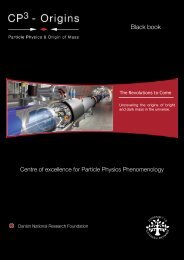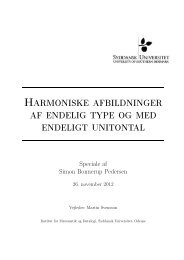Slides from the talk - CP3-Origins
Slides from the talk - CP3-Origins
Slides from the talk - CP3-Origins
Create successful ePaper yourself
Turn your PDF publications into a flip-book with our unique Google optimized e-Paper software.
The interesting case of Quasi-Single Field Inflation<br />
k −3/2<br />
3 ln k 3<br />
,<br />
k 1<br />
QSF inflation predicts a family of models<br />
parametrized by<br />
α = 1 2 − ν ,<br />
m 2<br />
H 2 ≈ 9 (1)<br />
4 ,<br />
<br />
9 ν ≡ 4 − m2<br />
H 2 . “isocurvaton” fields, i.e. field (2)<br />
non-Gaussianity with intermediate and “shapes” is present between even<strong>the</strong><br />
if <strong>the</strong> non-Gaussianity is perfectly scaleheequilateral<br />
inflaton requires and local m 2 ≥ 0, so α ≥−1. As m 2 /H 2 > 9/4, <strong>the</strong> isocurvatons<br />
significant effects on density perturbations. So we are mainly interested in<br />
a momentum dependence lies between that of <strong>the</strong> equilateral shape (α = 1)<br />
large non-Gaussianity or its direct multifield generalization, and that of <strong>the</strong><br />
ultifield models with light isocurvatonssqueezed-limit<br />
m H. (See [9–11] for reviews.)<br />
n <strong>the</strong> isocurvaton masses may be model-dependent in more general situations,<br />
dependence in <strong>the</strong> squeezed limit is a robust evidence for <strong>the</strong> existence of such<br />
atively as follows [6, 7]. The fluctuations of <strong>the</strong> massive scalars decay after<br />
y decay immediately after <strong>the</strong> horizon-exit, and for lighter scalars <strong>the</strong>y decay<br />
responsible for <strong>the</strong> large non-Gaussianities, are <strong>the</strong>refore generated between<br />
n scales. The former<br />
ν = 0.2<br />
is responsible for <strong>the</strong> equilateral-like ν = 1 shapes, and <strong>the</strong><br />
cy check, if we look at <strong>the</strong> special limit of massless scalars, <strong>the</strong> superhorizon<br />
over <strong>the</strong> characteristic local shape in <strong>the</strong> squeezed limit. This momentum<br />
titatively as follows [8], at least for α close to −1 . Ignoring <strong>the</strong> physics within<br />
ed limit of <strong>the</strong> three-point function can be regarded as <strong>the</strong> modulation of <strong>the</strong><br />
ngth modes <strong>from</strong> a long-wavelength mode. After horizon exit, we know that<br />
ays as ∼ a −1−α • Inflationary phenomenology.<br />
as a function of <strong>the</strong> scale factor a. So <strong>the</strong> amplitude of <strong>the</strong><br />
1+α<br />
m is <strong>the</strong> mass of <strong>the</strong><br />
orthogonal to <strong>the</strong> inflaton<br />
trajectory in field-space<br />
Figure 1. Thisfigureillustratesamodelofquasi-singlefieldinflation in ter<br />
The θ direction is <strong>the</strong> inflationary direction, with a slow-roll potential. The<br />
isocurvature direction, which typically has mass of order H.<br />
PHYSICAL REVIEW D 81, 063511 (2010)<br />
larger than O(H), quasi-single field inflation makes <strong>the</strong> same predic<br />
inflation. However, once large couplings exist and <strong>the</strong> mass are of orde<br />
<strong>the</strong>se massive isocurvatons can have important effects on density pert<br />
In this paper, we shall study a simple model of quasi-single fiel<br />
model, <strong>the</strong> coupling between <strong>the</strong> inflaton and <strong>the</strong> massive isocurvat<br />
turning trajectory. The tangential direction of this turning trajector<br />
direction, while <strong>the</strong> orthogonal direction is lifted by a mass oforderH<br />
The motivations for investigating quasi-single field inflation are<br />
• UV completion and fine-tuning in inflation models. To satisfy t<br />
tion, fine-tunings or symmetries should generally be evoked. Atl<br />
<strong>the</strong> case for models that have reasonable UV completion in string<br />
ity [3, 4]. For slow-roll inflation, this means that, in <strong>the</strong> inflati<br />
light fields will typically acquire mass of order <strong>the</strong> Hubble para<br />
heavy to be <strong>the</strong> inflaton candidates. On <strong>the</strong> o<strong>the</strong>r hand, in a UV<br />
tiple light fields arise naturally. Taking <strong>the</strong>se facts into considera<br />
of inflation emerges: There is one inflation direction with mass m<br />
directions in <strong>the</strong> field space with m ∼ H. In contrast to <strong>the</strong> sl<br />
higher order terms in <strong>the</strong> potential such as V ′′′ ∼ H and V ′′′′ ∼<br />
<strong>the</strong>se non-flat directions. To have more than one flat direction n<br />
The above picture for inflation suggests <strong>the</strong> quasi-single field in<br />
When Chen <strong>the</strong> & inflaton Wang trajectory (2010) tu<br />
isocurvature perturbation is converted to curvature perturbation<br />
ing <strong>the</strong> effect of such a conversion on density perturbations is in








